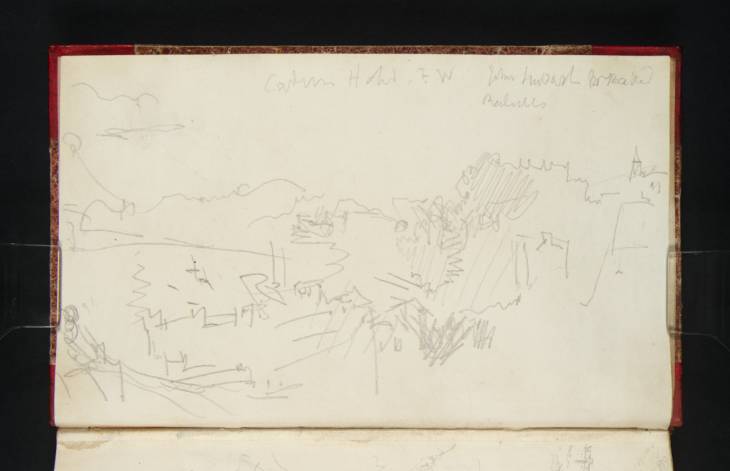J.M.W. Turner
>
1830-35 Annual tourist
>
Scotland 1831
>
Staffa Sketchbook
>
Artwork
Joseph Mallord William Turner Tobermory Bay from the Hill Above Main Street 1831
Image 1 of 2
Joseph Mallord William Turner,
Tobermory Bay from the Hill Above Main Street
1831
Joseph Mallord William Turner 1775–1851
Folio 1 Verso:
Tobermory Bay from the Hill Above Main Street 1831
D26749
Turner Bequest CCLXXIII 1a
Turner Bequest CCLXXIII 1a
Pencil on white wove paper, 116 x 186 mm
Inscribed in pencil by Turner ?‘Cardm H ohn FW John Hadard Mr Bader | Balalls’ top
Inscribed in pencil by Turner ?‘Cardm H ohn FW John Hadard Mr Bader | Balalls’ top
Accepted by the nation as part of the Turner Bequest 1856
References
1909
A.J. Finberg, A Complete Inventory of the Drawings of the Turner Bequest, London 1909, vol.II, p.875, CCLXXIII 1a, as ‘On the coast.’.
Tobermory is the main village on Mull and was where Turner caught the Maid of Morven steamboat to the Isle of Staffa. He was therefore at Tobermory at least twice on his tour of 1831, once on his return from Skye and again on his return from Staffa. He may also have stopped at Tobermory on his journey from Oban to Skye, although the sequence of sketches in the Sound of Mull no.1 (Tate D26936–D26948; D26950–D26954; D41019–D41020 complete; Turner Bequest CCLXXIV) and Sound of Mull no.2 (Tate D26955–D26965; D41021–D41022 complete; Turner Bequest CCLXXV) sketchbooks suggests that the boat went straight on to Skye without stopping.
The Tobermory sketches in the Staffa sketchbook are split into two groups: folios 1–1a, 2a–3a (D26748–D26749, D26751–D26753) and folios 41–49 (D26819–D26836). This has led David Wallace-Hadrill and Janet Carolan to speculate that the two groups were made on separate occasions; the first before he left for Staffa and the second on his return. The authors acknowledge that ‘those familiar with Turner’s habit of leaving gaps in his sketchbooks may feel that such discontinuity in the spacing of sketches does not necessarily constitute discontinuity in the making of them.’ However, they go on to assert that ‘a gap of nearly forty pages stretches the argument further than it can bear.’1 Their suggestion is supported by the fact that the two groups come before and after Turner’s sketches of Staffa in the sketchbook. However, the fact that both groups contain sketches made from the hill to the south of the harbour begs the question: why Turner should return to the same spot twice. In summary, it is likely that Turner was in Tobermory twice, and he may have made sketches on both occasions.
The present sketch shows a view from the hillside above the Main Street which runs along Tobermory Bay (probably from Argyll Terrace), looking south-east over rooftops to the southern end of the bay, where the masts of several boats can be seen. There are just a few clouds in the sky above the harbour, and although we cannot see the sun’s disk Turner has included its reflection in the water below. The sun is in the east so the sketch must have been made in early morning.
A sketch on folio 1 (D26748) shows rooftops and the same turreted building that is at the right of the present sketch. There is also a very similar view on folio 2 verso (D26751) which shows the pier more clearly. Folio 3 (D26752) was made from a lower viewpoint closer to the bay, but sketches on folios 44–46 (D26825–D26829), which show the view to the north-east were probably also made from Argyll Terrace. Folio 46 verso (D26830) was probably made from Middle Brae, a road that runs down from Argyll Terrace to Main Street, where Turner continued sketching on folios 47 and 47 verso (D26831, D26832). The other sketches showing Tobermory, or those which are inscribed with the name, were made from the Sound of Mull.
An inscription across the top of the page lists several names, though unfortunately Turner’s handwriting is too vague to make much sense of them: ‘Cardm H ohn FW John Hadard Mr Bader | Balalls’. The final word may perhaps refer to Ballachulish, a place Turner was later to pass on his journey to Inverness (see folio 2; D26750). It is worth noting an inscription in a similar vein on folio 47 verso, which David Wallace-Hadrill and Janet Carolan have read as: ‘D. [?]Barns & Co, Dyer and [Colours?], and Niel McPar. Smithy’.2 This may refer to the names of the shops or proprietors that can be seen in the sketch, suggesting that Turner may have been doing something similar here. Wallace-Hadrill and Carolan have also suggested that the letters ‘FW’ in the inscription on the present page may stand for Fort William, although they acknowledge that the town more closely resembles Tobermory.3
Thomas Ardill
March 2010
How to cite
Thomas Ardill, ‘Tobermory Bay from the Hill Above Main Street 1831 by Joseph Mallord William Turner’, catalogue entry, March 2010, in David Blayney Brown (ed.), J.M.W. Turner: Sketchbooks, Drawings and Watercolours, Tate Research Publication, December 2012, https://www


